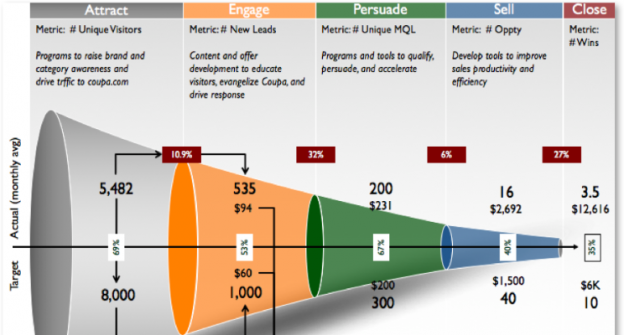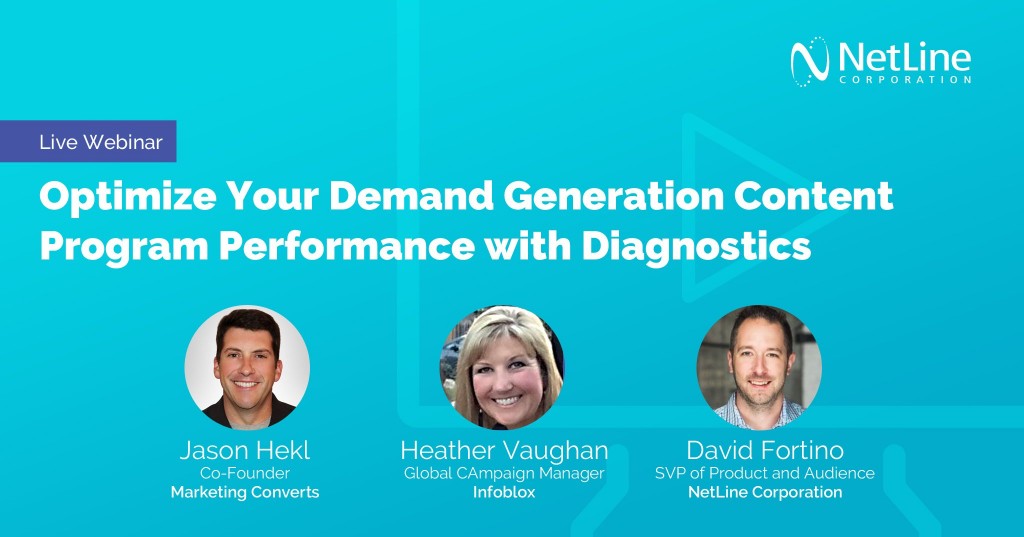*This guest post has been provided by Jason Hekl, Co-Founder and Principal of Marketing Converts
Optimizing Demand Generation Performance with Funnel Diagnostics
When I first arrived on the scene as a demand marketer over a dozen years ago, I did so armed with a spreadsheet model for the funnel I was going to fill with leads and pipeline opportunities. As spreadsheets go, it was sexy; and it played well both with my CEO and the board I had to report to every month. I could show the output from our marketing activities, and how those leads converted into pipeline and closed-won business. It allowed me to calculate a return on our marketing investment.
But that sexy spreadsheet didn’t make me a better marketer.
Being a better marketer means taking a critical eye to the programs and tactics you run within the context of the audience you are attempting to attract, engage, qualify and convert, to diagnose performance and identify and prioritize improvements for that audience-specific marketing effort. When you have just one funnel, you’re aggregating output from all your programs, for all the products you sell to a potentially wide and varied audience. So, as a singular construct, “the” funnel is useful for directional analysis only, and has limited value as a diagnostic.
If you accept that argument, and adopt a mindset to expand use of the funnel beyond modeling and measurement, to diagnostics and optimization, a new world of opportunity will open to you. You can isolate multiple funnels by audience-offering pairings, form Tiger Teams (a diversified group of experts brought together for a single project, need, or event assigned to investigate, solve, build, or recommend possible solutions to unique situations or problems) that look across all marketing and sales activities related to that audience-offering pairing, and adopt processes to continuously diagnose performance and institute changes to optimize performance. In some months, that may focus resources at the top of the funnel, but in others you may determine the resources are better applied deeper in the funnel.
This data-driven Renaissance in marketing places a far greater emphasis on measuring and optimizing for impact, and it’s characterized by constant experimentation. To see how powerful this can be for the B2B marketer, let’s consider this through the lens of a tried-and-true marketing tactic: content syndication.
The Basics: Content-Centric Programs
Let me lay out the most common scenario for content syndication. A campaign manager sources a white paper or other content asset from the product marketing organization and devises a plan to maximize the number of downloads for that asset at the lowest possible cost per unit. The campaign manager posts the asset to the company website and may run advertising to draw attention to it. She will contract with syndication networks to negotiate a low CPL by marketing it to a broad audience.
Because the asset is educational and has broad business appeal, it drives a lot of registrations, which are immediately delivered as leads to the SDR or sales organization for follow-up without much in the way of analysis or prioritization. Success is determined by the number of people who registered for the content, and the cost per lead (though I would argue these hardly constitute ‘leads’). The campaign manager does almost nothing beyond lead delivery to analyze program performance. In my experience, this high volume tactical execution of content marketing through syndication networks does little more than build a database of pseudo-qualified individuals who may not even match the buyer personas of people likely to have a need for your product.
The program itself is independent of any funnel diagnostic and originates from the asset being promoted. It’s run as an always-on program, in a “set it and forget it” mode that completely under-utilizes the channel. Findings published in NetLine’s ‘2017 State of Content Consumption and Demand Report for B2B Marketers’ report confirm this practice. According to that study, 98% of marketers oriented their 2016/2017 content syndication strategy to top-of-funnel (ToFu) programs, largely ignoring how to leverage syndication programs for middle-of-funnel (MoFu) and bottom-of-funnel (BoFu) initiatives.
More Advanced: Audience-Specific Programs
A more strategic utilization of content syndication taps into immediate feedback loops for ongoing experimentation. Under this scenario, the organizing principle for the syndication program is the audience-offering pairing, and the specific revenue or pipeline goals associated with that pairing. Multiple such programs are run in parallel, each with distinct goals tied to advancing buying progression based on the needs of each specific audience. Campaign managers executing programs in this way are constantly experimenting, and discovering new insights that factor into their ongoing optimization efforts. Answering one question often leads to new questions and hypotheses, and that mindset leads to broad experimentation.
In practice, this takes on many forms. I spoke to one digital marketer recently who shared how he is experimenting through content syndication.
“We had done some preliminary message testing on Facebook to see what messages resonated with the audience we wanted. Based on our research, we came up with four different titles for an asset we were refreshing with our new branding. Out of the four, two did markedly better than the others. Even more interesting, one of the top two performers did markedly better with the C-level audience, whereas the second one performed better with the operator-level audience. And that was fascinating. It’s the exact same paper.”
That insight then led into additional questions about the C-level audience, and a specific ‘Benefactor’ program targeted specifically to them. He analyzed performance data in pivot tables, discovered patterns, and used those insights to design increasingly specific and targeted programs for each audience.
It doesn’t stop there, though. I’ve seen another company take an equally compelling strategic approach to leveraging content syndication channels. They started by defining several buyer personas in their target audience, and then mapped content to each persona for each buying stage. Rather than syndicate all content at once, though, they activated that content based on a diagnostic of the audience-offering funnel. When the volume of qualified leads at the top of the funnel was below forecast, they promoted the education-stage content. When the volume of leads hit a threshold target, they put more spend into promoting consideration and purchase stage content for that audience, trading volume for influence later in the buying cycle. This data-driven approach allows them to adapt their syndication programs with the changing shape of each audience-offering funnel.
What’s Next? Integrated Programs that Flex with your Funnel
If you think about this progression, solely through the lens of content syndication, you start with a program that centers on promoting a content asset to maximize the number of registrations or downloads. That’s often the status quo, and not terribly innovative or impactful.
The first advance is to define the programs more narrowly, through the lens of a specific audience-offering pairing, and to use syndication to continuously test content assets and define narrower segments to target. The second advance is to adjust each targeted program by the real-time needs dictated by an audience-offering funnel diagnostic. Look at how the governing principle changes in each progression: first, it’s all about the content asset. In the second, it’s all about matching the asset to the right audience-offering pairing. And in the third, its triggering the right program mix based on the real-time needs of a funnel diagnostic.
Each iteration in grounded in experiment-based learning, and leads to further optimization. Now apply that mindset across a broader set of marketing tactics, and you quickly begin to see how this could apply across the full marketing mix, and evolve into integrated marketing programs that flex and adapt with the changing needs of your sales organization. All driven by the funnel diagnostic you are using to evaluate performance for each audience-offering pairing. In essence, this becomes a data-driven approach to optimizing marketing and sales activities that will yield the best results across all levels of the funnel based on what is needed at any given time.
What do you think? Have you built a marketing engine that flexes with your funnel? Please share examples of how you answered the ‘so what?’ question with funnel diagnostics, and applied that insight to optimize performance, and maybe I’ll feature you in my November 8th webinar with David Fortino of NetLine and Heather Vaughan of Infoblox.
Being a better marketer means taking a critical eye to the programs and tactics you run within the context of the audience you are attempting to attract, engage, qualify and convert, to diagnose performance and identify and prioritize improvements for that prospect-specific marketing effort. Register now for this demand generation webinar as Heather, David, and I explore demand generation funnel diagnostics. (Wed. November 8th.)

